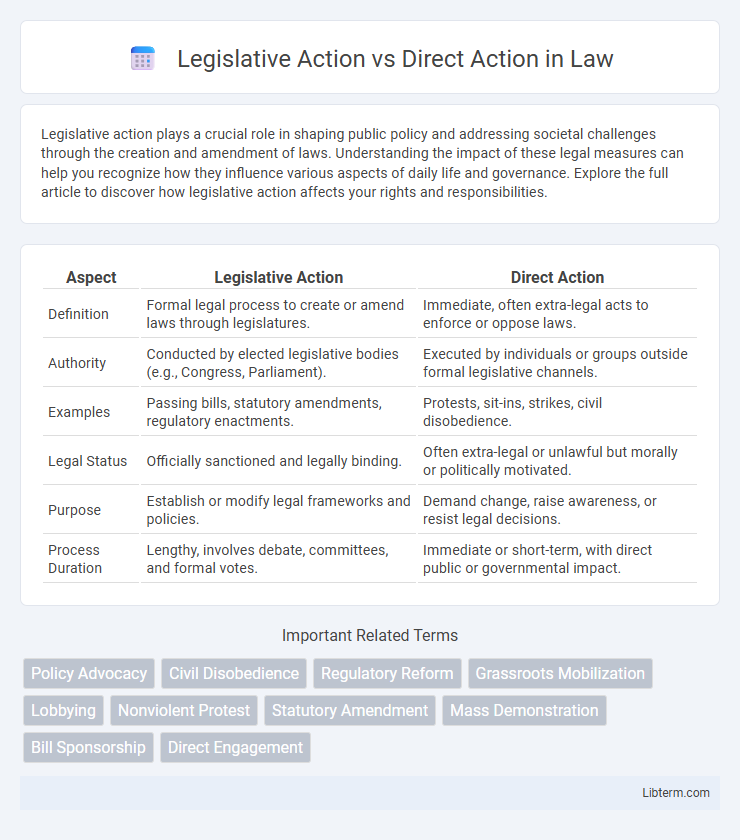Legislative action plays a crucial role in shaping public policy and addressing societal challenges through the creation and amendment of laws. Understanding the impact of these legal measures can help you recognize how they influence various aspects of daily life and governance. Explore the full article to discover how legislative action affects your rights and responsibilities.
Table of Comparison
| Aspect | Legislative Action | Direct Action |
|---|---|---|
| Definition | Formal legal process to create or amend laws through legislatures. | Immediate, often extra-legal acts to enforce or oppose laws. |
| Authority | Conducted by elected legislative bodies (e.g., Congress, Parliament). | Executed by individuals or groups outside formal legislative channels. |
| Examples | Passing bills, statutory amendments, regulatory enactments. | Protests, sit-ins, strikes, civil disobedience. |
| Legal Status | Officially sanctioned and legally binding. | Often extra-legal or unlawful but morally or politically motivated. |
| Purpose | Establish or modify legal frameworks and policies. | Demand change, raise awareness, or resist legal decisions. |
| Process Duration | Lengthy, involves debate, committees, and formal votes. | Immediate or short-term, with direct public or governmental impact. |
Introduction to Legislative Action and Direct Action
Legislative action involves influencing lawmaking processes through formal channels like lobbying, drafting bills, and working with policymakers to enact or amend legislation. Direct action emphasizes grassroots tactics such as protests, sit-ins, and civil disobedience to create immediate pressure and public awareness. Both strategies play critical roles in shaping social and political change by targeting different mechanisms of influence.
Defining Legislative Action: Processes and Key Players
Legislative action involves systematically drafting, debating, and enacting laws through formal political institutions such as parliaments or congresses, where elected officials and legislative committees serve as key players influencing policy outcomes. This process includes proposal introduction, committee review, floor debates, and voting, with stakeholders like lobbyists, interest groups, and public officials actively engaging to shape legislation. Understanding these procedural steps and influential actors highlights how legislative action functions as a structured mechanism for addressing social issues through legal and policy frameworks.
Understanding Direct Action: Forms and Objectives
Direct action encompasses tactics like protests, sit-ins, strikes, and civil disobedience aimed at creating immediate social or political change without relying on legislative processes. These actions seek to disrupt the status quo, draw public attention, and pressure authorities or institutions to address specific issues directly. Forms of direct action often emphasize grassroots participation and can effectively mobilize communities to challenge injustices or advocate for urgent reforms.
Historical Context: Evolution of Both Strategies
Legislative action has evolved through formal political processes, such as the passage of landmark laws like the Civil Rights Act of 1964, which demonstrated the power of institutional change. Direct action emerged prominently during the 20th century with events like the Greensboro sit-ins and the Montgomery Bus Boycott, emphasizing grassroots mobilization and civil disobedience to demand immediate social justice. Both strategies reflect distinct but complementary approaches that shaped social movements, balancing systemic reform with urgent public pressure.
Comparing Effectiveness: Legislative vs Direct Action
Legislative action involves influencing policymakers to enact laws or regulations, which can create long-term systemic change but often requires time, negotiation, and compromise. Direct action, such as protests or sit-ins, generates immediate public attention and can pressure authorities to respond quickly but may lack lasting structural impact without accompanying policy changes. Comparing effectiveness depends on context: legislative action secures formal legal protections, while direct action drives urgent awareness and mobilizes grassroots support.
Legal and Ethical Implications
Legislative action involves creating or amending laws through formal governmental processes, ensuring changes are legally sanctioned and subject to checks and balances, which upholds institutional legitimacy but can be slow and constrained by political interests. Direct action bypasses formal legal channels, employing protests, civil disobedience, or strikes to demand immediate change, often raising ethical debates about the justification of breaking laws to confront perceived injustices. Both approaches pose critical legal and ethical implications: legislative action emphasizes rule of law and democratic process, while direct action challenges legality to address urgent moral imperatives, balancing social order against the right to dissent.
Case Studies: Successes and Failures
Legislative action in environmental policy offers structured, enforceable change, as seen in the Clean Air Act's success in reducing pollutants, while direct action, such as Greenpeace's protests against whaling, raises public awareness but sometimes faces legal pushback limiting long-term impact. Case studies reveal legislative measures often secure lasting reforms through policymaker engagement, yet can be slow and compromised by political interests. Direct action drives immediate attention to urgent issues, exemplified by the Standing Rock protests, but without legislative backing, these efforts risk fading without systemic change.
Public Perception and Media Representation
Legislative action is often perceived as a formal, authoritative approach to change, garnering media coverage that emphasizes legality and institutional legitimacy. Direct action captures public attention through dramatic visuals and urgent messaging, often framed by media as disruptive or grassroots-driven. Media representation can shape public perception by highlighting order in legislative efforts, while portraying direct action as a catalyst for social urgency.
Strategic Considerations: Combining Both Approaches
Strategic considerations in combining legislative action and direct action emphasize the complementary strengths of institutional policy change and public pressure mobilization. Integrating lobbying efforts with grassroots campaigns amplifies influence on lawmakers while sustaining media attention and community engagement. This dual approach leverages formal advocacy and mass participation to maximize the impact on social or political reform initiatives.
Conclusion: Choosing the Right Path for Social Change
Legislative action offers structured, long-term solutions through policy changes enacted by government bodies, ensuring legal and systemic impact. Direct action bypasses formal channels, utilizing immediate, grassroots tactics like protests and sit-ins to raise awareness and pressure for change. Selecting the right approach depends on goals, context, and urgency, often combining both to maximize social movement effectiveness.
Legislative Action Infographic

 libterm.com
libterm.com